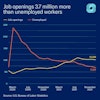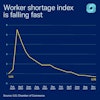Explore industries
We hear every day from our member companies—of every size and industry, across nearly every state—as we move into 2022, they’re still facing unprecedented challenges trying to find enough workers to fill open jobs.
But just how widespread is this problem? And how do we begin to address this national economic crisis and put more Americans back to work?
That’s what we set out to discover. By analyzing more than two decades worth of federal jobs and employment data and conducting surveys of top industry association economists and state and local chamber leaders across the country, we examined the current state of the American workforce and the monumental challenges employers are facing across the country.
Here’s what we learned.
Executive Summary and Key Findings
The most critical and widespread challenge facing businesses is the inability to hire qualified workers for open jobs they need to fill. When businesses do not have enough employees, they are forced to turn down work, reduce hours, scale back their operations, and in the worst cases, permanently close. The latest data and surveys reveal a national economic crisis that is getting steadily worse.
- There were 10.6 million vacant job openings in the United States—a record high—at the end of November 2021, the latest month for which data is available. Employers added an astounding 3.8 million job openings in 2021.
- There are fewer than one available worker for every job opening (0.76 available workers/opening). This is the lowest the ratio has ever been, and it has only been less than one seven times since 2000, and five of those times were the last five months. The historical average, for context, is 2.7. And the ratio continues to fall.
- 94 percent of state and local chambers say businesses in their area are finding it difficult or very difficult to find workers. Almost all industry association economists say employers in their sectors struggle to find qualified workers for open jobs.
Macroeconomic Insights
In December, the Bureau of Labor Statistics (BLS) jobs report fell well below expectations.
Businesses only created 199,000 jobs when most analysts expected closer to 500,000. Even with 6.4 million unemployed at the beginning of December, Americans’ reluctance to return to work and fill open positions was one reason for the lackluster job creation. Another could be that employees know just how easy it is to get a new job – the percent and level of workers quitting their jobs are at all-time highs and have been for months.
BLS also reported 10.6 million job openings in the economy as of the end of November – near the 11 million all-time high set in July. In 2021, employers added 3.8 million job openings. Clearly, businesses are hiring – if only there were workers ready, able, and willing to fill their open positions.

The Worker Shortage Index (WSI) measures the number of available workers divided by job openings. More specifically, it compares (1) “available Workers” (persons who want a job and are available to work now) as reported in the monthly BLS Employment Situation Report household survey of individuals to (2) employers’ job openings as reported in the BLS Job Openings and Labor Turnover Survey (JOLTS).

The national Worker Shortage Index has fallen precipitously in recent months. There is now fewer than one available worker for every open job across the country. That’s the lowest the ratio has been since the data started in 2000 and well below the 2.7 historical average.
Hardest Hit States
While nearly all states face worker shortages, the data suggest that the challenge is particularly acute in several hard-hit states.
Thirty-three states have an index number (or WSI) below one, meaning jobs are more prevalent than potential workers in that industry.
The circumstances are most challenging for employers in Nebraska, Utah, Vermont, Georgia, and New Hampshire, where the total jobs available greatly outnumber the total available workers to fill them.
Local Chamber and Industry Association Survey
In December 2021, the U.S. Chamber of Commerce surveyed state and local chamber leaders about the state of the economy and the workforce challenges in their area—and the results are striking.

Ninety-four percent reported businesses are finding it “difficult” or “very difficult” for employers in their community or state to hire workers. Seventy-eight percent of respondents said the lack of available workers impacts the economy in their area the most.
A slim majority of respondents, 51 percent, say the economy in their area is “strong” or “very strong.” While more than 47 percent say the economy is “moderate.”
Economists from trade associations are a bit more optimistic about their sectors, with 71 percent saying their industry is “strong” or “very strong” and just 23 percent saying it is “moderate.”

In 2021, the U.S. economy rebounded strongly from a tumultuous 2020. After contracting 3.4% in 2020, the economy likely grew around 6% in 2021. The fourth-quarter numbers are not in yet, but expectations are for strong quarterly growth.
Early 2022 will likely see strong economic conditions continue, although the rise in cases because of Omicron complicates projections at this time. Nevertheless, even with the pandemic surging, inflation concerns, supply chain bottlenecks, and worker shortages, growth should remain strong in 2022. We are estimating over 4% growth for the year.
Despite the overall encouraging outlook right now, not all industries are faring the same, some are doing much better, and others are still struggling to rebound from COVID-19.
A more detailed explanation of the state of each of these industries is available in the sidebar menu.
Conclusion
Keeping our economy growing requires that we fill the jobs of today—and tomorrow. To do so, we need to remove barriers that prevent people from entering the workforce, get individuals the skills they need for the open positions, and enact sensible immigration policy.
If business and government work together to grow our workforce, we can once again build a vibrant, prosperous nation and lead the world economy for years to come.
The U.S. Chamber launched the America Works Initiative to help employers develop and hire the talent they need to succeed, build an American workforce that’s prepared for the jobs of today and tomorrow, and unleash America’s economic potential and long-term competitiveness.
About the author

Curtis Dubay
Curtis Dubay is Chief Economist, Economic Policy Division at the U.S. Chamber of Commerce. He heads the Chamber’s research on the U.S. and global economies.




